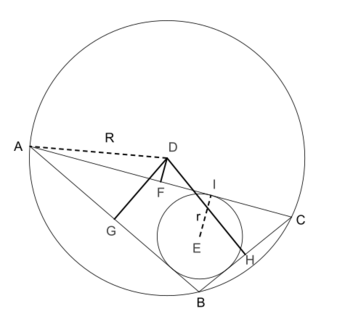Carnot's theorem
From HandWiki
In Euclidean geometry, Carnot's theorem states that the sum of the signed distances from the circumcenter D to the sides of an arbitrary triangle ABC is
- [math]\displaystyle{ DF + DG + DH = R + r,\ }[/math]
where r is the inradius and R is the circumradius of the triangle. Here the sign of the distances is taken to be negative if and only if the open line segment DX (X = F, G, H) lies completely outside the triangle. In the diagram, DF is negative and both DG and DH are positive.
The theorem is named after Lazare Carnot (1753–1823). It is used in a proof of the Japanese theorem for concyclic polygons.
External links
- Weisstein, Eric W.. "Carnot's theorem". http://mathworld.wolfram.com/CarnotsTheorem.html.
- Carnot's Theorem at cut-the-knot
- Carnot's Theorem by Chris Boucher. The Wolfram Demonstrations Project.


